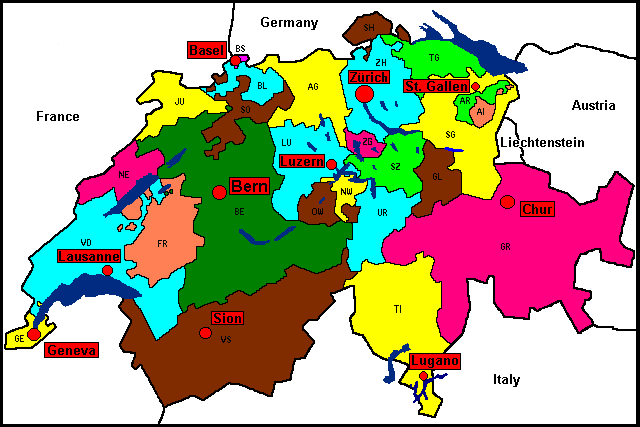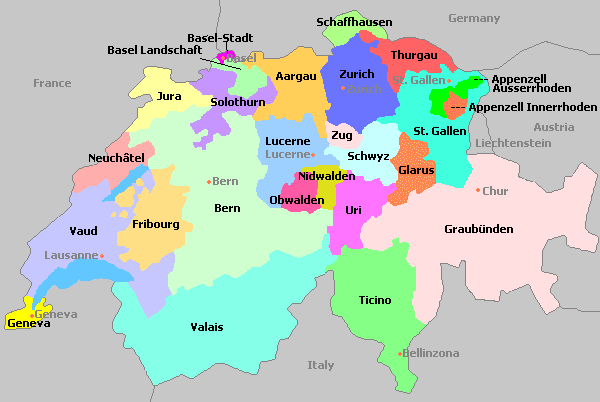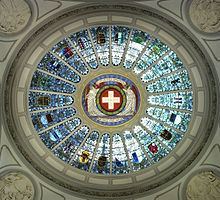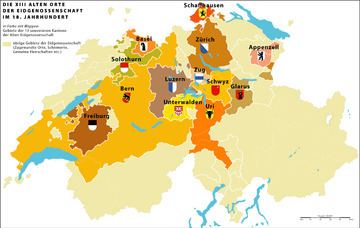Created 16th century | ||
 | ||
Number 26 cantons (as of 1979) Populations 15,778 (Canton of Appenzell Innerrhoden) – 1,421,895 (Canton of Zürich) | ||
Cantons of switzerland kantone der schweiz cantoni della svizzera cantons de la suisse
The 26 cantons of Switzerland (German: Kanton, French: canton, Italian: cantone, Romansh: chantun) are the member states of the Swiss Confederation. The nucleus of the Swiss Confederacy in the form of the first three confederate allies used to be referred to as the Waldstätte. Two further major steps in the development of the Swiss cantonal system are referred to by the terms Acht Alten Orte ("confederation of eight"; during 1353–1481) and Dreizehn Alten Orte ("Thirteen-Canton Confederation", during 1513–1798); they were important intermediate periods of the Ancient Swiss Confederacy.
Contents
- Cantons of switzerland kantone der schweiz cantoni della svizzera cantons de la suisse
- Terminology and its historical development
- History
- Constitution
- Direct democracy
- List
- Half cantons
- Names in national languages
- Admission of new cantons
- References

Each canton (or in earlier times: Statt ("site/settlement"), or Städte und Länder ("towns and countries/countrysides"), or Ort (lit.: place, referring to "souvereign territory", "community"), or Stand ("estate") from the 13th century to around 1800) was a fully sovereign state with its own border controls, army, and currency from the Treaty of Westphalia (1648) until the establishment of the Swiss federal state in 1848; with a brief period of centralized government during the Helvetic Republic (1798–1803). With the Napoleonic period of the Helvetic Republic the term canton/cantone/Kanton was fully established. From 1833, there were 25 cantons, which became 26 after the secession of the canton of Jura from Bern in 1979.

Terminology and its historical development

The term canton, now also used as English term for administrative subdivisions of other countries, originates in French usage in the late 15th century, from a word for "edge, corner" (recorded in Fribourg in 1475). After 1490, canton was increasingly used in French and Italian documents to refer to the members of the Swiss Confederacy.

English use of canton in reference to the Swiss Confederacy (as opposed to the heraldic sense) dates to the early 17th century.

In German Switzerland, the term Ort (plural: Orte; lit.: place; referring to "souvereign territory", "community") was in use from the early 15th century as a generic term uniting the towns and rural allies previously named separately as Städte ("towns") and Länder ("countries; countrysides"), or even just Stett/Statt (plural: Stätte, "site/settlement") prior and during the early constitution of the Ancient Swiss Confederacy.
It was increasingly replaced by Stand (plural: Stände, "estate") after 1550.
The French term canton was not adopted into German usage prior to 1648, and after that only in occasional use. The prominent usage of Ort and Stand only gradually disappeared in German-speaking Switzerland with the Helvetic Republic. Only with the Act of Mediation of 1803 did German Kanton become an official designation, retained in the Swiss Constitution of 1848.
The term Stand remains in synonymous usage (in French état) and is reflected in the name of the upper chamber of the Swiss Parliament, the Council of States (German: Ständerat, French: Conseil des États, Italian: Consiglio degli Stati, Romansh: Cussegl dals Stadis).
Some cantonal constitutions provide for a longer formal name of the state. Most of Romandy's cantons (Geneva, Jura, Neuchâtel, Valais and Vaud) and Ticino call themselves république/Repubblica ("republics") officially, at least within their constitutions. For example, the canton of Geneva refers to itself formally as the République et canton de Genève ("Republic and canton of Geneva").
History
In the 16th century, the Old Swiss Confederacy was composed of 13 sovereign confederate allies (German: Dreizehn Alten Orte), and there were two different kinds: five rural states – Uri, Schwyz (which became eponymous of the confederacy), Unterwalden, Glarus, Appenzell – and eight urban states – Zürich, Bern, Luzern, Zug, Basel, Fribourg, Solothurn, Schaffhausen.
Though they were technically part of the Holy Roman Empire, they had become de facto independent when the Swiss defeated Emperor Maximillian in 1499 in Dornach.
In the early modern period, the individual confederate allies came to be seen as republics; while the six traditional allies had a tradition of direct democracy in the form of the Landsgemeinde, the urban states operated via representation in city councils, de facto oligarchic systems dominated by families of the patriciate.
The old system was abandoned with the formation of the Helvetic Republic following the French invasion of Switzerland in 1798. The cantons of the Helvetic Republic had merely the status of an administrative subdivision with no sovereignty. The Helvetic Republic collapsed within five years, and cantonal sovereignty was restored with the Act of Mediation of 1803. The status of Switzerland as a federation of states was restored, at the time including 19 cantons (the six accessions to the early modern Thirteen Cantons being composed of former associates and subject territories: St. Gallen, Grisons, Aargau, Thurgau, Ticino, Vaud). Three additional western cantons, Valais, Neuchâtel and Geneva, acceded in 1815.
The process of "Restoration", completed by 1830, returned most of the former feudal rights to the cantonal patriciates, leading to rebellions among the rural population. The Liberal Radical Party embodied these democratic forces calling for a new federal constitution. This tension, paired with religious issues ("Jesuit question") escalated into armed conflict in the 1840s, with the brief Sonderbund War. The victory of the radical party resulted in the formation of Switzerland as a federal state in 1848. The cantons retained far-reaching sovereignty, but were no longer allowed to maintain individual standing armies or international relations. As the revolutions of 1848 in Western Europe had failed elsewhere, Switzerland during the later 19th century (and with the exception of the French Third Republic, until the end of World War I) found itself as an isolated democratic republic, surrounded by the restored monarchies of France, Italy, Austria-Hungary and Germany.
Constitution
Each canton has its own constitution, legislature, government and courts. Most of the cantons' legislatures are unicameral parliaments, their size varying between 58 and 200 seats. A few legislatures are general assemblies known as Landsgemeinden. The cantonal governments consist of either five or seven members, depending on the canton. For the names of the institutions, see List of legislative and executive councils of the Cantons of Switzerland.
The Swiss Federal Constitution declares the cantons to be sovereign to the extent that their sovereignty is not limited by federal law. The cantons also retain all powers and competencies not delegated to the Confederation by the Constitution. Most significantly, the cantons are responsible for healthcare, welfare, law enforcement and public education; they also retain the power of taxation. The cantonal constitutions determine the degree of autonomy accorded to the municipalities, which varies but almost always includes the power to levy taxes and pass municipal laws. The areas of the cantons vary from 37 km2 to 7,105 km2; the populations vary from 15,471 to 1,244,400.
Direct democracy
As on the federal level, all cantons provide for some forms of direct democracy. Citizens may demand a popular vote to amend the cantonal constitution or laws, or to veto laws or spending bills passed by the parliament. General popular assemblies (Landsgemeinde) are now limited to the cantons of Appenzell Innerrhoden and Glarus. In all other cantons democratic rights are exercised by secret ballot.
List
The cantons are listed in their order of precedence given in the federal constitution. This reflects the historical order of precedence of the Eight Cantons in the 15th century, followed by the remaining cantons in the order of their historical accession to the confederacy.
The two-letter abbreviations for Swiss cantons are widely used, e.g., on car license plates. They are also used in the ISO 3166-2 codes of Switzerland with the prefix "CH-" (Confœderatio Helvetica—Helvetian Confederation—Helvetia having been the ancient Roman name of the region). CH-SZ, for example, is used for the canton of Schwyz.
Half-cantons
Six of the 26 cantons are traditionally, but no longer officially, called "half-cantons" (German: Halbkanton, French: demi-canton, Italian: semicantone, Romansh: mez-chantun), reflecting a history of mutual association or partition.
The half-cantons are identified in the first article of the Swiss Federal Constitution of 1999 by being joined to their other "half" with the conjunction "and":
The People and the Cantons of Zürich, Bern, Lucerne, Uri, Schwyz, Obwalden and Nidwalden, Glarus, Zug, Fribourg, Solothurn, Basel-Stadt and Basel-Landschaft, Schaffhausen, Appenzell Ausserrhoden and Appenzell Innerrhoden, St. Gallen, Graubünden, Aargau, Thurgau, Ticino, Vaud, Valais, Neuchâtel, Geneva, and Jura form the Swiss Confederation.
The 1999 constitutional revision retained this distinction, on the request of the six cantonal governments, as a way to mark the historic association of the half-cantons to each other. In contrast, the first article of the 1848 and 1874 constitutions constituted the Confederation as the union of "twenty-two sovereign cantons", referring to the half-cantons as "Unterwalden (ob und nid dem Wald [‘above and beneath the woods’])", "Basel (Stadt und Landschaft [‘city and country’])" and "Appenzell (beider Rhoden [‘both Rhoden’])". While the older constitutions referred to these states as "half-cantons", a term that remains in popular use, the 1999 revision and official terminology since then use the appellation "cantons with half of a cantonal vote".
With their mutual association a purely historical matter, the half-cantons are since 1848 equal to the other cantons in all but two respects:
The reasons for the association between the three pairs of half-cantons are varied:
In the 20th century, some Jurassic separatists suggested a new canton of Jura to be divided into half-cantons of North Jura and South Jura. Instead, North Jura became the (full) canton of Jura while South Jura remains in the canton of Bern as the region of Bernese Jura.
Names in national languages
The name of each canton in its own official language is shown in bold.
Admission of new cantons
The enlargement of Switzerland by way of the admission of new cantons ended in 1815. After a failed attempt of Vorarlberg to join Switzerland in 1919, the idea of resuming Swiss enlargement was revived in 2010 by a parliamentary motion that would allow the accession of regions bordering on Switzerland.
